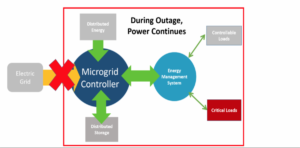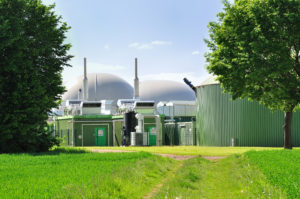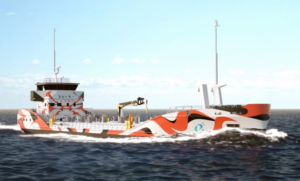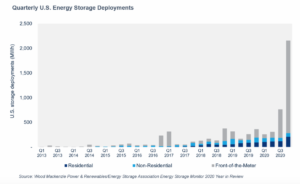In This Issue
-
Flanigan’s Eco-Logic: Saluting the Aspen Skiing Company for Climate Action
- Microgrids 1.4: The Santa Rita Union School District Story
- Carbon Negative News
- All-Electric Tankers
- Hydrogen Updates: Saudi Arabia and Hydrogen Goop
- Energy Storage Updates
- The NetPositive Podcast with Andrew Waddell on Hillside Solar

Flanigan’s Eco-Logic: Saluting the Aspen Skiing Company for Climate Action
In this issue, we salute the Aspen Skiing Company, locally known in Colorado’s Roaring Fork Valley, as “Ski Co.” Some years ago, it developed a novel approach to generate power while demonstrating a cost-effective fix to a local problem with global impacts. The project involved capturing methane emissions from an abandoned mine in the town of Somerset – miles from Aspen’s slopes and in neighboring Gunnison County. Once captured, the methane has been and continues to be combusted to generate electricity. The Ski Co did two things at once: It made a sound investment while taking highly progressive climate action.
This was the brainchild of my colleague and friend, the late Randy Udall. We worked together at Rocky Mountain Institute, after which he ran CORE, the Community Office for Resource Efficiency, a non-profit dedicated to saving energy and cutting carbon. He realized the potency of methane… what he called “carbon on steroids.” Molecule-for-molecule and over 20 years, methane has 80 times the greenhouse gas intensity of carbon dioxide. It’s potent stuff. Randy viewed it as a local resource. It’s a fuel. By capturing the methane and safely converting it through combustion, its GHG potency is dramatically downgraded.
Auden Schendler, a former employee of mine, and now Vice President of Environmental Sustainability at Ski Co, explains that it had been focused on energy for years to drive down its carbon footprint. It had done small and pioneering solar and hydro projects… but it wanted to generate significant power to offset its load.
Udall and Schendler approached the Elk Creek Mine in Somerset owned by Bill Koch. Initially, they got the cold shoulder: The mine was pulling a million dollars of coal out of the ground each day and thus a million-dollar-a-year methane capture plant was not of particular interest. Udall and Schendler, however, were persistent and ultimately the mine did allow the novel project.
Ski Co made a $5.3 million investment in the methane capture plant that opened in 2012. The plant generates 3 MW of baseload power, while preventing emissions of 250 billion cubic feet of methane annually into the atmosphere. Ski Co sells the plant’s output directly to Holy Cross Energy, earning generation and carbon credit values. A fire in the mine caused a setback, but didn’t kill the project. In fact, the fire resulted in closure of the mine in 2014. The mine, however, will emit methane for the next 20 – 30 years. Ski Co’s methane capture plant remains fully operational. It will be fully paid off this year after reaping an 8% annual return.
Another former RMI colleague, Rick Heede, now runs the Carbon Accountability Institute. Heede too salutes Ski Co and reports that there are 48,528 abandoned mines in the country, many still dumping methane into the air. So will Ski Co do it again? Schendler explains the efforts that he and his colleagues went through to replicate the project… all to no avail. High risks, small returns, so probably not. He travelled to several states looking for projects without success. While mine methane capture is standard practice in Europe, it has yet to catch on in America.
Ski Co deserves great credit for giving it a go, being an innovator extraordinaire. Through methane capture – collecting a dangerous, atmospheric pollutant – it is generating enough power for its entire four-mountain operation. Now Schendler is focused on the next model project, a net-zero hotel in Mammoth, California using that region’s rich geothermal energy for heating.
Check out The NetPositive Podcast with Ted Flanigan featuring Auden Schendler. A terrific storyteller, Auden describes Ski Co’s energy and methane capture works… the genesis, challenges, environmental benefits, economics, and leadership:
Audio Player

 This story is about EcoMotion’s own first adventures with microgrids. We were hired by the Santa Rita Union School District in October 2015. It’s an elementary and middle school district in Monterey County, California… specifically in Salinas, the home of Steinbeck.
This story is about EcoMotion’s own first adventures with microgrids. We were hired by the Santa Rita Union School District in October 2015. It’s an elementary and middle school district in Monterey County, California… specifically in Salinas, the home of Steinbeck.
 Oil tankers and cargo ships are some of the biggest and most polluting vehicles on the planet. The heavy fuel oil that they burn has a high sulfur content. Now a consortium of Japanese companies has teamed up to develop the world’s first all-electric tankers.
Oil tankers and cargo ships are some of the biggest and most polluting vehicles on the planet. The heavy fuel oil that they burn has a high sulfur content. Now a consortium of Japanese companies has teamed up to develop the world’s first all-electric tankers. Hydrogen Goop:
Hydrogen Goop:
 This edition of EcoNet News, Volume 23, Issue #3 is also available in podcast format. Check out The NetPositive with Ted Flanigan on Spotify, Apple, and Google. Episodes includes Convos (Conservations), the News (EcoNet News), and Uni (the EcoMotion University).
This edition of EcoNet News, Volume 23, Issue #3 is also available in podcast format. Check out The NetPositive with Ted Flanigan on Spotify, Apple, and Google. Episodes includes Convos (Conservations), the News (EcoNet News), and Uni (the EcoMotion University).